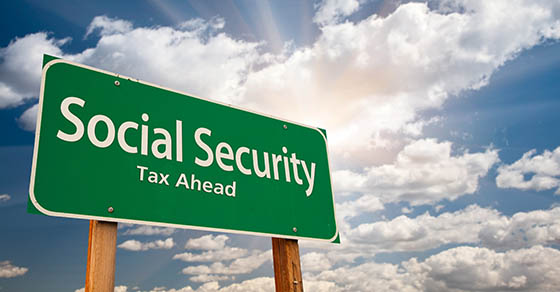Weekly Tax Brief
Significant changes to information reporting go into effect for the 2026 tax year
- Details
- Published: 16 December 2025 16 December 2025

If your business has employees or uses independent contractors, you have associated annual information reporting obligations. The One Big Beautiful Bill Act (OBBBA) makes changes impacting these rules, but not for the 2025 tax year.
Tips and overtime income
For 2025 through 2028, the OBBBA creates new deductions for employees who receive qualified tips income or qualified overtime income. Importantly, these breaks aren’t income exclusions. Therefore, federal payroll taxes and federal income tax withholding rules still apply to this income. Also, qualified tips and qualified overtime may still be fully taxable for state and local income tax purposes where applicable.
The issue for employers and payroll management firms is reporting qualified tips and qualified overtime amounts so eligible workers can claim their rightful federal income tax deductions. In August, the IRS announced that, for tax year 2025, there will be no OBBBA-related changes to federal information returns for individuals, federal payroll tax returns or federal income tax withholding tables. So, the 2025 versions of Form W-2, Forms 1099, Form 941 and other payroll-related forms and returns aren’t being changed.
In November, the IRS issued guidance on how taxpayers who’ve received tips or overtime in 2025 can determine their eligibility and calculate their deductions, considering that employers and others aren’t required to provide information reporting specific to qualified tips income or qualified overtime income for the 2025 tax year.
Employers and payroll management firms may voluntarily report 2025 qualified tips in Box 14 (“Other”) of Form W-2 or a separate statement. Those that pay overtime, at minimum, should be prepared to answer employee questions about whether they’re considered to be Fair Labor Standards Act employees and thus potentially eligible for the qualified overtime deduction for 2025.
Eligible occupations for the tips deduction
In September 2025, the IRS released proposed regulations that include a list of dozens of occupations that are eligible for the OBBBA deduction for qualified tips income. Eligible occupations have been given a three-digit code to be used by employers for information return purposes.
Eligible occupations are grouped into eight categories: beverage and food service, entertainment and events, hospitality and guest services, home services, personal services, personal appearance and wellness, recreation and instruction, and transportation and delivery.
Draft 2026 Form W-2
In September 2025, the IRS also released a draft of the 2026 Form W-2. The draft form incorporates changes to support the new employer reporting requirements for employee deductions for qualified tips income and qualified overtime income, as well as employer contributions to Trump accounts (which will become available in 2026 to provide a tax-advantaged savings opportunity for children).
For Box 12 of the draft form, new codes are provided for the following:
- “TA” to report employer contributions to Trump accounts,
- “TP” to report the total amount of an employee’s qualified tips income, and
- “TT” to report the total amount of an employee’s qualified overtime income.
Box 14b has been added for employers to report the occupation of an employee who receives qualified tips income.
Eased information return rules
While the deductions for qualified tips and overtime will add to the information reporting requirements for businesses, the OBBBA also provides some reporting relief. This relief also starts with the 2026 tax year.
Businesses generally must report on annual information returns, such as Form 1099-MISC, payments made during the year that equal or exceed the threshold for rents, royalties, premiums, annuities, remuneration, emoluments, or other fixed or determinable gains, profits, and income. In addition, businesses that receive business services generally must report on annual information returns, such as Form 1099-NEC, payments made during the year for services rendered that equal or exceed the statutory threshold.
For many years, the threshold for Forms 1099-MISC and 1099-NEC has been $600. Effective for payments made after 2025, the OBBBA increases the reporting threshold to $2,000, with inflation adjustments for payments made after 2026. This change will impact information returns that should be filed in early 2027 to report affected 2026 payments.
Stay up to date
Additional guidance on reporting requirements for qualified tips income and qualified overtime income is expected, and eventually final 2026 information reporting forms will be released. Contact us to keep up to date on developments and what you need to do to ensure your business is compliant with evolving reporting requirements.
© 2025
There’s still time to save 2025 taxes
- Details
- Published: 05 December 2025 05 December 2025

Just because it’s December doesn’t mean it’s too late to reduce your 2025 tax liability. Consider implementing one or more of these year-end tax-saving ideas by December 31.
Defer income and accelerate deductions
Pushing income into the new year will reduce this year’s taxable income. If you’re expecting a bonus at work, for example, ask if your employer can hold off on paying it until January. If you’re self-employed, you can delay sending invoices so that they won’t be paid until January and thus postpone the revenue to 2026.
If you itemize deductions, remember that deductions generally are claimed for the year of payment. So, if you make your January 2026 mortgage payment in December, you can deduct the interest portion on your 2025 tax return. Similarly, if you’ve received your 2026 property tax assessment and pay it by December 31, you can claim it on your 2025 return (provided your total state and local taxes don’t exceed the applicable limit).
But don’t follow this approach if you expect to be in a higher tax bracket next year. Also, if you’re eligible for the qualified business income deduction for pass-through entities, consider how this approach might affect it.
Harvest investment losses
An investment loss has a bit of an upside — it gives you the opportunity to offset taxable gains. If you sell investments at a loss before the end of the year, you can offset gains realized this year on a dollar-for-dollar basis.
If you have more losses than gains, you generally can apply up to $3,000 of the excess to reduce your ordinary income ($1,500 if you’re married and filing separately). Any remaining losses are carried forward to future tax years.
Donate appreciated stock to charity
If you want to give to charity, you can simply write a check or use a credit card. Or you can donate from your taxable investment portfolio, which sometimes saves more tax.
By donating appreciated publicly traded stock, you can claim a charitable deduction (assuming you itemize deductions) equal to the current market value of the shares at the time of the gift. Plus, you escape any capital gains taxes you’d owe if you sold those shares.
But don’t donate stock worth less than it cost. Instead, sell the shares so you can claim a capital loss, which can reduce your taxes now or in the future as discussed above. Then, give the sales proceeds to a charity and claim a charitable deduction.
Maximize retirement contributions
Making pretax or tax-deductible contributions to traditional retirement accounts — such as a 401(k) plan, Savings Incentive Match Plan for Employees (SIMPLE), IRA and Simplified Employee Pension (SEP) plan — can be a significant tax saver.
For 2025, taxpayers can contribute pretax as much as $23,500 to a 401(k) or $16,500 to a SIMPLE. The IRA contribution limit is $7,000, though your deduction may be reduced or eliminated if you or your spouse also contributes to an employer-sponsored plan. Self-employed individuals can contribute up to 25% of net income (but no more than $70,000) to a SEP IRA.
Taxpayers age 50 or older by December 31 can also make “catch-up” contributions of up to $7,500 to a 401(k) or $3,500 to a SIMPLE and $1,000 to a traditional IRA. Those age 60, 61, 62 or 63 can make an additional catch-up contribution of up to $3,750 to a 401(k) or $1,750 to a SIMPLE.
The deadline for making 2025 401(k) and SIMPLE contributions is generally December 31, 2025. (And if you want to increase the amount that’s deferred from your paycheck, you’ll need to check with your plan on whether increases for the year are still allowed.) But you might be able to make deductible 2025 IRA contributions as late as April 15, 2026, and deductible 2025 SEP contributions as late as the extended 2025 filing deadline of October 15, 2026.
Act soon
Most of the ideas discussed here must be implemented by December 31 to reduce your 2025 taxes. So act soon. Let us know if you have questions or are looking for more last-minute tax-saving strategies.
© 2025
6 last-minute tax tips for businesses
- Details
- Published: 02 December 2025 02 December 2025

Year-round tax planning generally produces the best results, but there are some steps you can still take in December to lower your 2025 taxes. Here are six to consider:
1. Postpone invoicing. If your business uses the cash method of accounting and it would benefit from deferring income to next year, wait until early 2026 to send invoices.
2. Prepay expenses. A cash-basis business may be able to reduce its 2025 taxes by prepaying certain 2026 expenses — such as lease payments, insurance premiums, utility bills, office supplies and taxes — before the end of the year. Many expenses can be deducted even if paid up to 12 months in advance.
3. Buy equipment. Take advantage of 100% bonus depreciation and Section 179 expensing to deduct the full cost of qualifying equipment or other fixed assets. Under the One Big Beautiful Bill Act, 100% bonus depreciation is back for assets acquired and placed in service after January 19, 2025. And the Sec. 179 expensing limit has doubled, to $2.5 million for 2025. But remember that the assets must be placed in service by December 31 for you to claim these breaks on your 2025 return.
4. Use credit cards. What if you’d like to prepay expenses or buy equipment before the end of the year, but you don’t have the cash? Consider using your business credit card. Generally, expenses paid by credit card are deductible when charged, even if you don’t pay the credit card bill until next year.
5. Contribute to retirement plans. If you’re self-employed or own a pass-through business — such as a partnership, S corporation or, generally, a limited liability company — one of the best ways to reduce your 2025 tax bill is to increase deductible contributions to retirement plans. Usually, these contributions must be made by year-end. But certain plans — such as SEP IRAs — allow your business to make 2025 contributions up until its tax return due date (including extensions).
6. Qualify for the pass-through deduction. If your business is a sole proprietorship or pass-through entity, you may be able to deduct up to 20% of qualified business income (QBI). But if your 2025 taxable income exceeds $197,300 ($394,600 for married couples filing jointly), certain limitations kick in that can reduce or even eliminate the deduction. One way to avoid these limitations is to reduce your income below the threshold — for example, by having your business increase its retirement plan contributions.
Most of these strategies are subject to various limitations and restrictions beyond what we’ve covered here. Please consult us before implementing them. We can also offer more ideas for reducing your taxes this year and next.
© 2025
Have you used up your 2025 FSA funds?
- Details
- Published: 20 November 2025 20 November 2025

If you have a flexible spending account (FSA) through your employer to help pay for health or dependent care expenses, now’s a good time to check your balance. FSAs save taxes, but they generally require you to incur expenses to use the funds by year end or forfeit them. Here’s a refresher on the rules and limits.
FSAs for health care
A maximum pretax contribution of $3,300 to a health care FSA is permitted in 2025. (This amount is annually adjusted for inflation and will increase to $3,400 in 2026.) You use the pretax dollars to pay for medical expenses not covered by insurance.
An FSA allows you to save taxes without having to claim a medical expense deduction. This is beneficial because, to claim the deduction, you must itemize deductions on your tax return and the expenses are deductible only to the extent that they exceed 7.5% of your adjusted gross income. This threshold can be hard to meet. An added benefit of FSA contributions is that they aren’t subject to Social Security or Medicare taxes.
However, the “use-it-or-lose-it” rule means you must incur qualifying medical expenses by the last day of the plan year (December 31 for a calendar year plan) — unless the plan allows a grace period. A grace period can’t extend beyond the 15th day of the third month following the close of the plan year (March 15 for a calendar year plan). Alternatively, your FSA might allow you to roll over a balance of up to $660 to 2026. (The limit for rollovers from 2026 to 2027 will be $680.)
Take a look at your year-to-date FSA expenditures now to see how much you still need to spend. What are some ways to use up the money? Before year end (or the extended date, if permitted), schedule certain elective medical procedures, visit the dentist or buy new eyeglasses. Even over-the-counter medications and health-related supplies may be eligible.
FSAs for dependent care
Some employers also allow employees to set aside funds on a pretax basis in dependent care FSAs. A $5,000 maximum annual contribution is permitted ($2,500 for a married couple filing separately) in 2025. (This amount isn’t annually adjusted for inflation. But under the One Big Beautiful Bill Act, the limit will increase to $7,500 beginning in 2026.)
Dependent care FSAs can be used to pay dependent care expenses for:
- A child who qualifies as your dependent and who is under age 13, or
- A dependent or spouse who is physically or mentally incapable of self-care and who has the same principal place of abode as you for more than half of the tax year.
Like health FSAs, dependent care FSAs are subject to a use-it-or-lose-it rule, and grace period relief may apply. But rollovers to the next year aren’t allowed. Therefore, it’s a good idea to check your dependent care expenses to date.
Wrapping up 2025
As 2025 wraps up, be sure to review your FSA balance and check whether your plan offers a grace period or rollover option. Then take steps before year end to ensure you don’t forfeit any FSA funds. Ask your HR department any questions you have about your specific plan. We can answer your tax-related questions and provide more year-end tax planning tips.
© 2025
New deduction for QPP can save significant taxes for manufacturers and similar businesses
- Details
- Published: 18 November 2025 18 November 2025

The One Big Beautiful Bill Act (OBBBA) allows 100% first-year depreciation for nonresidential real estate that’s classified as qualified production property (QPP). This new break is different from the first-year bonus depreciation that’s available for assets such as tangible property with a recovery period of 20 years or less and qualified improvement property with a 15-year recovery period. Normally, nonresidential buildings must be depreciated over 39 years.
What is QPP?
The statutory definition of QPP is a bit complicated:
- QPP is the portion of any nonresidential real estate that’s used by the taxpayer (your business) as an integral part of a qualified production activity.
- A qualified production activity is the manufacturing, production or refining of a qualified product.
- A qualified product is any tangible personal property that isn’t a food or beverage prepared in the same building as a retail establishment in which the property is sold. (So a restaurant building can’t be QPP.)
In addition, an activity doesn’t constitute manufacturing, production or refining of a qualified product unless the activity results in a substantial transformation of the property comprising the product.
To sum up these rules, QPP generally means factory buildings. But additional rules apply.
Meeting the placed-in-service rules
QPP 100% first-year depreciation is available for property whose construction begins after January 19, 2025, and before 2029. The property generally must be placed in service in the United States or a U.S. possession before 2031. In addition, the original use of the property generally must commence with the taxpayer.
There’s an exception to the original-use rule. The QPP deduction can be claimed for a previously used nonresidential building that:
- Is acquired by the taxpayer after January 19, 2025, and before 2029,
- Wasn’t used in a qualified production activity between January 1, 2021, and May 12, 2025,
- Wasn’t used by the taxpayer before being acquired,
- Is used by the taxpayer as an integral part of a qualified production activity, and
- Is placed in service in the United States or a U.S. possession before 2031.
Also, the IRS can extend the before-2031 placed-in-service deadline for property that otherwise meets the requirements to be QPP if an Act of God (as defined) prevents the taxpayer from placing the property in service before the deadline.
Pitfalls to watch out for
While potentially valuable, 100% first-year deprecation for QPP isn’t without pitfalls:
Leased-out buildings. To be QPP, the building must be used by the taxpayer for a qualified production activity. So, if you’re the lessor of a building, you can’t treat it as QPP even if it’s used by a lessee for a qualified production activity.
Nonqualified activities. You can’t treat as QPP any area of a building that’s used for offices, administrative services, lodging, parking, sales activities, research activities, software development, engineering activities or other functions unrelated to the manufacturing, production or refining of tangible personal property.
Ordinary income recapture rule. If at any time during the 10-year period beginning on the date that QPP is placed in service the property ceases to be used for a qualified production activity, an ordinary income depreciation recapture rule will apply.
IRS guidance expected
QPP 100% first-year depreciation can be a valuable tax break if you have eligible property. However, it could be challenging to identify and allocate costs to portions of buildings that are used only for nonqualifying activities or for several activities, not all of which are qualifying activities. Also, once made, the election can’t be revoked without IRS consent. IRS guidance on this new deduction is expected. Contact us with questions and to learn about the latest developments.
© 2025
Shift income to take advantage of the 0% long-term capital gains rate
- Details
- Published: 13 November 2025 13 November 2025

Are you thinking about making financial gifts to loved ones? Would you also like to reduce your capital gains tax? If so, consider giving appreciated stock instead of cash. You might be able to eliminate all federal tax liability on the appreciation — or at least significantly reduce it.
Leveraging lower rates
Investors generally are subject to a 15% tax rate on their long-term capital gains (20% if their income exceeds certain thresholds). But the long-term capital gains rate generally is 0% for gain that would be taxed at 10% or 12% based on the taxpayer’s ordinary-income rate.
In addition, taxpayers with modified adjusted gross income (MAGI) over $200,000 ($250,000 for married couples filing jointly and $125,000 for married filing separately) may owe the net investment income tax (NIIT). The NIIT equals 3.8% of the lesser of your net investment income or the amount by which your MAGI exceeds the applicable threshold.
If you have loved ones in the 0% bracket, you may be able to take advantage of it by transferring appreciated assets to them. The recipients can then sell the assets at no or a low federal tax cost.
Case study
Faced with a long-term capital gains tax rate of 23.8% (20% for the top tax bracket, plus the 3.8% NIIT), Ed and Nancy decide to transfer some appreciated stock to their adult granddaughter, Emma. Just out of college and making only enough from her entry-level job to leave her with $30,000 in taxable income, Emma qualifies for the 0% long-term capital gains rate.
However, the 0% rate applies only to the extent that capital gains “fill up” the gap between Emma’s taxable income and the top end of the 0% bracket. For 2025, the 0% bracket for singles tops out at $48,350 (just $125 less than the top of the 12% ordinary-income tax bracket).
When Emma sells the stock her grandparents transferred to her, her capital gains are $20,000. Of that amount $18,350 qualifies for the 0% rate and the remaining $1,650 is taxed at 12%. Emma pays only $198 in federal tax on the sale vs. the $4,760 her grandparents would have owed had they sold the stock themselves.
More to consider
If you’re contemplating a gift to anyone who’ll be under age 24 on December 31, check whether they’ll be subject to the “kiddie tax.” Also consider any gift and generation-skipping transfer (GST) tax consequences. We’d be pleased to answer any questions you have. We can also suggest other ways you can reduce taxes on your investments.
© 2025
What you need to know about deducting business gifts
- Details
- Published: 11 November 2025 11 November 2025

Thoughtful business gifts are a great way to show appreciation to customers and employees. They can also deliver tax benefits when handled correctly. Unfortunately, the IRS limits most business gift deductions to $25 per person per year, a cap that hasn’t changed since 1962. Still, with careful planning and good recordkeeping, you may be able to maximize your deductions.
When the $25 rule doesn’t apply
Several exceptions to the $25-per-person rule can help you deduct more of your gift expenses:
Gifts to businesses. The $25 limit applies only to gifts made directly or indirectly to an individual. Gifts given to a company for use in its business — such as an industry reference book or office equipment — are fully deductible because they serve a business purpose. However, if the gift primarily benefits a specific individual at that company, the $25 limit applies.
Gifts to married couples. When both spouses have a business relationship with you and the gift is for both of them, the limit generally doubles to $50.
Incidental costs. The expenses of personalizing, packaging, insuring or mailing a gift don’t count toward the $25 limit and are fully deductible.
Employee gifts. Cash or cash-equivalent gifts (such as gift cards) are treated as taxable wages and generally are deductible as compensation. However, noncash, low-cost items — like company-branded merchandise, small holiday gifts, or occasional meals and parties — can qualify as nontaxable “de minimis” fringe benefits. These are deductible to the business and tax-free to the employee.
How entertainment gifts are treated now
Under the Tax Cuts and Jobs Act, most entertainment expenses are no longer deductible. This includes tickets to sporting events, concerts and other entertainment, even when related to business. However, if you give event tickets as a gift and don’t attend yourself, you may be able to classify the cost as a business gift, subject to the $25 limit and any applicable exceptions.
Note that meals provided during an entertainment event may still be 50% deductible if they’re separately stated on the invoice.
Why good recordkeeping matters
To claim the full deductions you’re entitled to, document your gifts properly. Record each gift’s description, cost, date and business purpose and the relationship of the recipient to your business. Digital records are acceptable — such as accounting notes or CRM entries — as long as they clearly support the deduction.
Track qualifying expenses separately in your books. That way they can be easily identified.
Make your business gifts count
A little knowledge and planning can go a long way toward ensuring your business gifts are both meaningful and tax-smart. If you’d like help reviewing your company’s gift-giving policies or want to confirm how the deduction rules apply to your situation, contact our office. We’ll help your business keep compliant with tax law while you show appreciation to your customers and employees.
Thoughtful business gifts are a great way to show appreciation to customers and employees. They can also deliver tax benefits when handled correctly. Unfortunately, the IRS limits most business gift deductions to $25 per person per year, a cap that hasn’t changed since 1962. Still, with careful planning and good recordkeeping, you may be able to maximize your deductions.
When the $25 rule doesn’t apply
Several exceptions to the $25-per-person rule can help you deduct more of your gift expenses:
Gifts to businesses. The $25 limit applies only to gifts made directly or indirectly to an individual. Gifts given to a company for use in its business — such as an industry reference book or office equipment — are fully deductible because they serve a business purpose. However, if the gift primarily benefits a specific individual at that company, the $25 limit applies.
Gifts to married couples. When both spouses have a business relationship with you and the gift is for both of them, the limit generally doubles to $50.
Incidental costs. The expenses of personalizing, packaging, insuring or mailing a gift don’t count toward the $25 limit and are fully deductible.
Employee gifts. Cash or cash-equivalent gifts (such as gift cards) are treated as taxable wages and generally are deductible as compensation. However, noncash, low-cost items — like company-branded merchandise, small holiday gifts, or occasional meals and parties — can qualify as nontaxable “de minimis” fringe benefits. These are deductible to the business and tax-free to the employee.
How entertainment gifts are treated now
Under the Tax Cuts and Jobs Act, most entertainment expenses are no longer deductible. This includes tickets to sporting events, concerts and other entertainment, even when related to business. However, if you give event tickets as a gift and don’t attend yourself, you may be able to classify the cost as a business gift, subject to the $25 limit and any applicable exceptions.
Note that meals provided during an entertainment event may still be 50% deductible if they’re separately stated on the invoice.
Why good recordkeeping matters
To claim the full deductions you’re entitled to, document your gifts properly. Record each gift’s description, cost, date and business purpose and the relationship of the recipient to your business. Digital records are acceptable — such as accounting notes or CRM entries — as long as they clearly support the deduction.
Track qualifying expenses separately in your books. That way they can be easily identified.
Make your business gifts count
A little knowledge and planning can go a long way toward ensuring your business gifts are both meaningful and tax-smart. If you’d like help reviewing your company’s gift-giving policies or want to confirm how the deduction rules apply to your situation, contact our office. We’ll help your business keep compliant with tax law while you show appreciation to your customers and employees.
How the Social Security wage base will affect your payroll taxes in 2026
- Details
- Published: 06 November 2025 06 November 2025

The 2026 Social Security wage base has been released. What’s the tax impact on employees and the self-employed? Let’s take a look.
FICA tax 101
The Federal Insurance Contributions Act (FICA) imposes two payroll taxes on wages and self-employment income — one for Old-Age, Survivors, and Disability Insurance, commonly known as the Social Security tax, and the other for Hospital Insurance, commonly known as the Medicare tax.
The FICA tax rate is 15.3%, which includes 12.4% for Social Security and 2.9% for Medicare. If you’re an employee, FICA tax is split evenly between your employer and you. If you’re self-employed, you pay the full 15.3% — but the “employer” half is deductible.
All wages and self-employment income are generally subject to Medicare tax. But the Social Security tax applies to such income only up to the Social Security wage base. The Social Security Administration has announced that the wage base will be $184,500 for 2026 (up from $176,100 for 2025). Wages and self-employment income above this threshold aren’t subject to Social Security tax.
Another payroll tax that higher-income taxpayers must be aware of is the additional 0.9% Medicare tax. It applies to FICA wages and self-employment income exceeding $200,000 ($250,000 for joint filers and $125,000 for separate filers). There’s no employer portion for this tax, but employers are required to withhold it once they pay an employee wages for the year exceeding $200,000 — regardless of the employee’s filing status. (You can claim a credit on your income tax return for withholding in excess of your actual additional Medicare tax liability.)
What will you owe in 2026?
For 2026, if you’re an employee, you’ll owe:
- 6.2% Social Security tax on the first $184,500 of wages, for a maximum tax of $11,439 (6.2% × $184,500), plus
- 1.45% Medicare tax on wages up to the applicable additional Medicare tax threshold, plus
- 2.35% Medicare tax (1.45% regular Medicare tax plus 0.9% additional Medicare tax) on all wages in excess of the applicable additional Medicare tax threshold.
For 2026, if you’re self-employed, you’ll owe:
- 12.4% Social Security tax on the first $184,500 of self-employment income (half of which will be deductible), for a maximum tax of $22,878 (12.4% × $184,500), plus
- 2.9% Medicare tax on self-employment income up to the applicable additional Medicare tax threshold (half of which will be deductible), plus
- 3.8% Medicare tax (2.9% regular Medicare tax plus 0.9% additional Medicare tax) on all self-employment income in excess of the applicable additional Medicare tax threshold. (Half of the 2.9% portion will be deductible; none of the 0.9% portion will be deductible.)
The payroll tax deduction for the self-employed can be especially beneficial because it reduces adjusted gross income (AGI) and modified adjusted gross income (MAGI). AGI and MAGI can trigger certain additional taxes and the phaseouts of many tax breaks.
Have questions?
Payroll taxes get more complicated in some situations. For example, what if you have two jobs? Payroll taxes will be withheld by both employers. Can you ask your employers to stop withholding Social Security tax once, on a combined basis, you’ve reached the wage base threshold? No, each employer must continue to withhold Social Security tax until your wages with that employer exceed the wage base. Fortunately, when you file your income tax return, you’ll get a credit for any excess withheld.
If you have more questions about payroll taxes, such as what happens if you have wages from a job and self-employment income, please contact us. We can help you ensure you’re complying with tax law while not overpaying.
© 2025
Year-end tax planning for accrual-basis taxpayers
- Details
- Published: 04 November 2025 04 November 2025

Projecting your business’s income for this year and next can allow you to time income and deductible expenses to your tax advantage. It’s generally better to defer tax — unless you expect to be in a higher tax bracket next year. Timing income and expenses can be easier for cash-basis taxpayers. But accrual-basis taxpayers have some unique tax-saving opportunities when it comes to deductions.
Review incurred expenses
The key to saving tax as an accrual-basis taxpayer is to properly record and recognize expenses that were incurred this year but won’t be paid until 2026. This will enable you to deduct those expenses on your 2025 federal tax return. Common examples of such expenses include:
- Commissions, salaries and wages,
- Payroll taxes,
- Advertising,
- Interest,
- Utilities,
- Insurance, and
- Property taxes.
You can also accelerate deductions into 2025 without actually paying for the expenses in 2025 by charging them on a credit card. (This works for cash-basis taxpayers, too.)
Look at prepaid expenses
Review all prepaid expense accounts. Then write off any items that have been used up before the end of the year.
If you prepay insurance for a period of time beginning in 2025 and ending in 2026, you can expense the entire amount this year rather than spreading it between 2025 and 2026, as long as a proper method election is made.
More tips to consider
Be sure to review your outstanding receivables and write off any that you can establish as uncollectible. Also, pay interest on shareholder loans. For more information on these strategies and to discuss other ways your business can reduce 2025 taxes, contact us.
© 2025
Is an HDHP plus an HSA a financially smart health care option for you?
- Details
- Published: 30 October 2025 30 October 2025

Health care costs continue to increase. Pairing a high-deductible health plan (HDHP) with a Health Savings Account (HSA) can help. Insurance premiums will be lower because of the high deductible. And the HSA provides a tax-advantaged way to fund the deductible and other medical expenses.
5 HSA tax benefits
HSAs offer both current and future tax savings:
1. Your contributions are pretax or tax deductible. This saves you tax in the year contributions are made.
2. Contributions your employer makes aren’t included in your taxable income. Again, you save tax in the current year.
3. Earnings on the HSA funds aren’t taxed as long as they remain in the account. HSAs can bear interest or be invested and grow on a tax-deferred basis, similar to a traditional IRA.
4. Distributions to pay qualified medical expenses aren’t taxed. This means you benefit from permanent tax savings. (If funds are withdrawn from the HSA for other reasons, the distribution is taxable. Generally, a 20% penalty will also apply.)
5. Distributions after age 65 are penalty-free even if not used for medical expenses. But they’re still taxable. So, HSAs can help fund retirement, again, similar to a traditional IRA.
Annual limits
You can contribute to an HSA only if you have an HDHP. For 2026, an HDHP is health insurance with an annual deductible of at least $1,700 for self-only coverage or $3,400 for family coverage. (These amounts increased from $1,650 and $3,300, respectively, for 2025.) Additionally, the 2026 out-of-pocket expenses you’re required to pay for covered benefits can’t exceed $8,500 for self-only coverage or $17,000 for family coverage (up from $8,300 and $16,600, respectively, for 2025).
Beginning in 2026, the definition of HDHP will be expanded. It also will include Bronze and Catastrophic plans available on state and federal insurance exchanges under the Affordable Care Act.
For self-only coverage, the 2026 HSA contribution limit is $4,400. For family coverage, it’s $8,750. (These amounts are up from $4,300 and $8,550, respectively, for 2025.) If you’re age 55 or older by year-end, you may make additional “catch-up” contributions of up to $1,000.
The annual contribution limit is reduced if you have an HDHP for only part of the year or go on Medicare at some point during the year. But you can still take tax-free distributions from your HSA for qualified medical expenses.
Determining your best option
The combination of an HDHP and an HSA can be financially smart, particularly for healthy individuals who don’t currently have many medical expenses. Such individuals can reduce premium costs today and potentially build up substantial HSA funds to use in the future, such as to cover the costs of a major health issue or to supplement their retirement plans. But an HDHP-HSA pairing isn’t the best option for everyone. Contact us to discuss the tax and financial aspects of funding your health care.
© 2025





